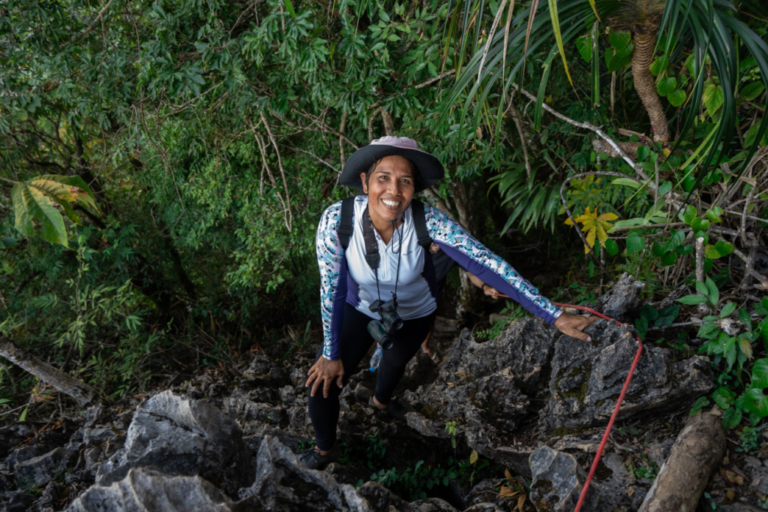By Climate Champions | July 18, 2024
An interview with: Cheunjit ‘Chuen’ Chuaysong, community-based tourism guide & entrepreneur
Country & Region: Khao Sok, Thailand
Breakthrough: Coastal Tourism
Beneficiaries / Impact: Thailand aims to generate tourism revenue of 3.5 trillion baht (around US$95.45 billion) in 2024, with an expected 40 million foreign visitors this year, up from 28 million in 2023. That said, tourism plays a significant role in their economy, employing 4.1 million people, over 10% of the population. In 2023, Khao Sok National Park in southern Thailand attracted approximately 347.32 thousand tourists. Here, Andaman Discoveries— a leader in community-based tourism — continues to support local communities through various sustainable projects, emphasizing long-term social, economic, and environmental benefits. Community-based tourism (CBT), which emerged in Thailand in the 1990s, focuses on sustainable tourism driven by local people.
—
At 47, Cheunjit ‘Chuen’ Chuaysong stands as one of the last individuals born in Khao Sok National Park, Thailand—a rainforest with biodiversity rivaling the Amazon. She is among the few women wilderness guides in the area who have championed community-based tourism and successfully engaged the next generation in this effort. Passionate about the natural world and her home, she also highlights the challenges her community faced when Khao Sok took on its status as a national park. The story of Khao Sok is complex, and it challenges assumptions about the role of national parks in conservation and their impact on local lives.
As part of an ongoing series to support the Climate Champions, the Edges of Earth expedition followed Chuen on extended tours of the forest, her community, and her growing businesses. Chuen’s life has been filled with obstacles, yet her strength comes from a commitment to something greater than herself. In her own words below, Chuen describes how she finds pleasure not in status or material possessions, but rather in the natural world and through a rich sense of community.
Coastal Tourism is one of the five sectors identified as part of the Ocean Breakthroughs that must undergo a significant transformation in order deliver on the 2050 vision of the ocean designed by the Ocean for Climate Declaration.
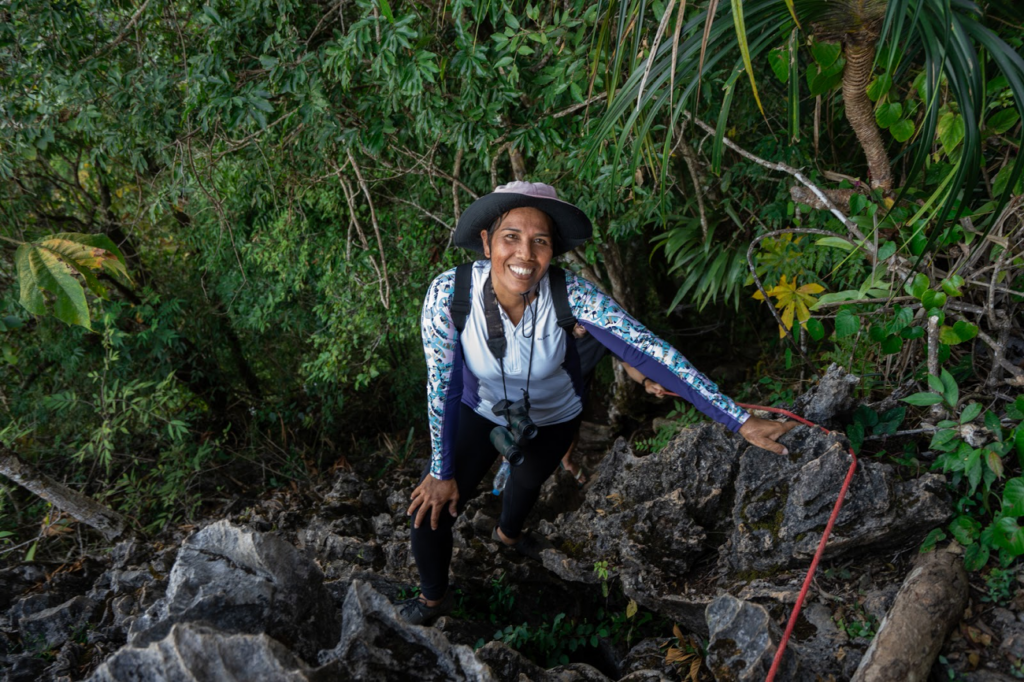
Cheunjit ‘Chuen’ Chuaysong, community-based tourism guide & entrepreneur. Photo Credit: Marla Tomorug
THE COMPLICATED HISTORY OF THE LAKE
Adapting to new surroundings was more challenging than living off the land. After being displaced, I spent the next 20 years learning to navigate this new world, with tourism becoming my lifeline. Determined to make my mark in the male-dominated field of wilderness guiding, I pursued this path not just for myself, but also to support my son as a single mother. From our time together in the forest, you know that my community’s history is unrecorded. The forest was my everything, and guiding tours is now my way to stay connected to my culture, heritage, and traditions. This is as close as I can get to my roots. Adapting and moving on was essential, and we made it work. We are a peaceful community; when told to leave, we didn’t fight.
Khao Sok is known for its limestone mountains and the Cheow Lan Lake. But what I love the most here is the rainforest, home to elephants, gibbons, giant hornbills. To most, Khao Sok appears as an untamed wilderness; to me, it’s home. Though I don’t know all the specifics, Khao Sok was once a massive coral reef stretching from China all the way to Borneo! People living in the forest go back generations, with communities like mine settling here only in the last century. I loved living in the forest, mastering the rhythms of the animals and learning to live off the land. That’s why I’m such a good wilderness guide because I learned it all when I was a girl.
Right when I was born in the 70’s, student activists ran away to Khao Sok to escape a military crackdown in the city. For eight years, this area became safe for them, keeping them hidden from the Thai military and inadvertently creating protection of the area from logging and poaching, which was bound to destroy the forest. And by 1980, Khao Sok was designated a national park.
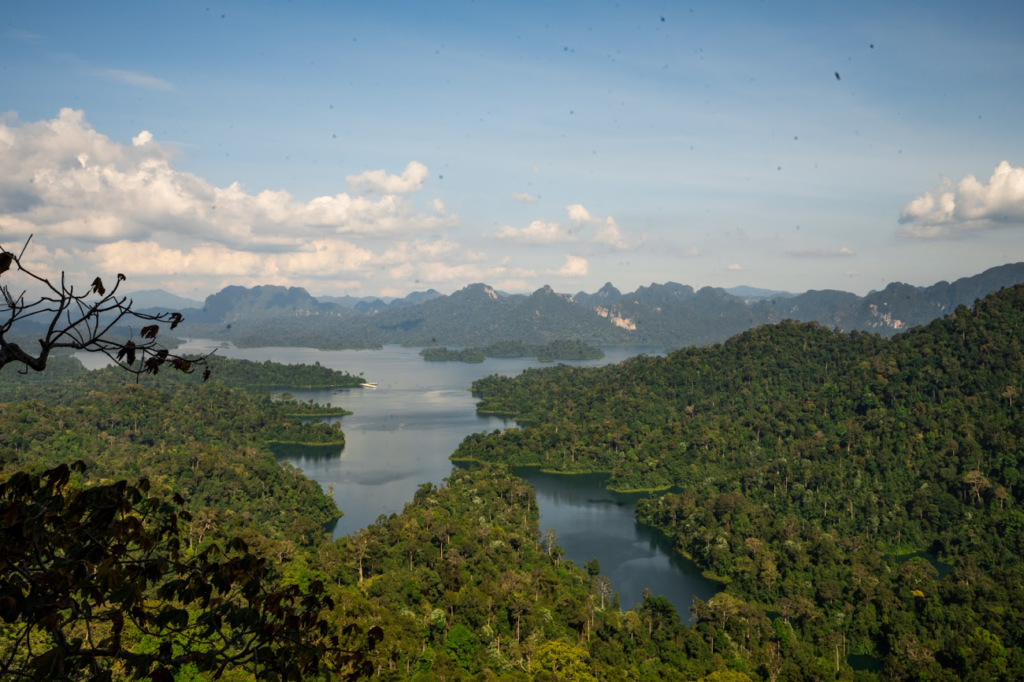
Khao Sok National Park. Photo Credit: Marla Tomorug
That’s when the Electricity Generating Authority of Thailand started a hydroelectric development project that changed everything. In 1982, the Rajaprabha Dam was built, creating Cheow Larn Lake, which now runs the hydroelectricity in the area. While the dam and the national park helped protect nature, my community was displaced from the forest.
Over three years, rising water levels forced us to relocate as our home was submerged underwater. Many animals had to be moved, but unfortunately, most died in the process. We were promised a better life outside the forest with infrastructure and connectivity, but the transition was painful, and left a lasting impact on the 300 families in my community. It was especially difficult for my grandparents and parents—despite our relief that the park was saved.
THE COMMUNITY-BASED TOURISM APPROACH
I’ve been guiding for the last ten years. While everyone visits for the scenery, I help them understand the deeper community story, especially for those who are curious! Before that, I spent twenty years working in the hotel industry across Thailand and spent a lot of time learning English. When I was younger, tourism didn’t exist here, and now it’s a lifeline for our community, just like the plantations.
I returned home to support community-based tourism, ensuring that we share profits so everyone can thrive. I run a textiles business called Chiewlan, collaborating with local women to create additional income streams. My focus will shift more towards this once my son finishes school. And I work with Andaman Discoveries on various community-based tourism projects. Recently, I established a new restaurant in our community, providing more job opportunities in the tourism industry. I’m also dedicated to training the next generation of tour guides, emphasizing junior guiding.
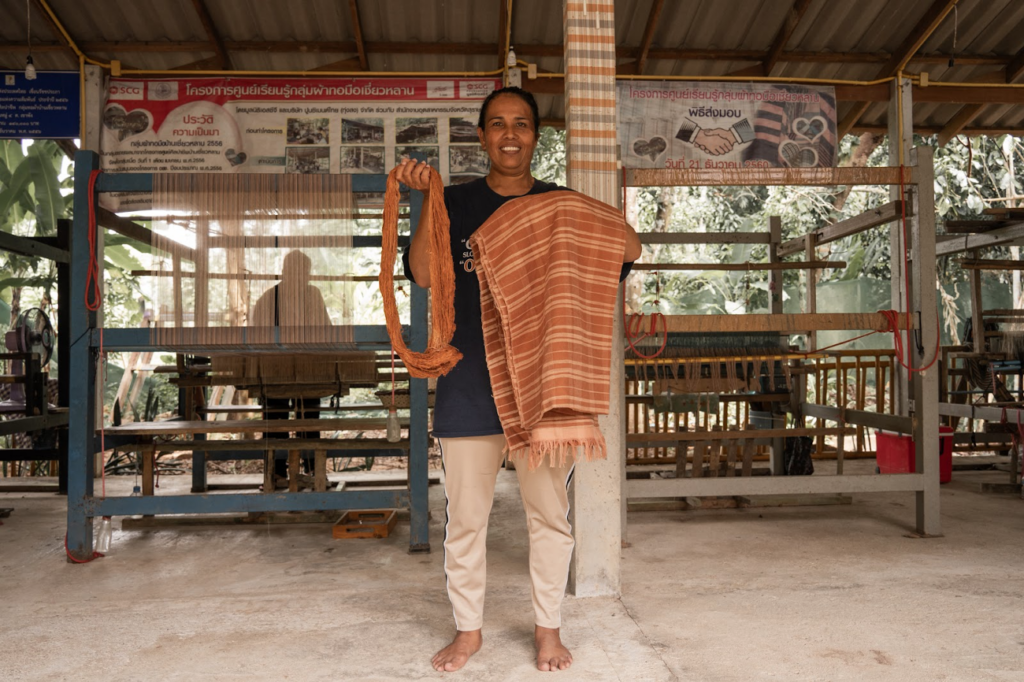
Chuen sharing her weaving at her textiles business. Photo Credit: Marla Tomorug.
I wanted to come back to my home and help with what we call community-based tourism, which I do with Andaman Discoveries. That’s when we all work together and we all share the profit. I have a textiles business called Chiewlan that I’ve been running for a little less than ten years, working with the local women to create new income streams. I want to focus on this more once my son is done with school. Recently, I set up a newly established restaurant in the community that helps more people find jobs in the tourism industry. I’m also working to train the next generation of tour guides right now through what we call the Guide Club.
Today, we need to care for the environment just as much as we care for the community. We play a big role in both the security and sustainability of our land and people. Sharing knowledge and supporting the new generation by making sure they get a proper education is so important. Many of us are getting older, and we need the next generation to step up in tourism. We pass down our knowledge and skills, encouraging them to undergo training, obtain their IDs, and start working. We’re teaching them about guiding, but also about keeping our lakes and rivers clean. We have 26 people in our club, and more are joining! As the club secretary, I document everything and make sure the club keeps moving.
We control our system and stand for our people by creating more jobs and promoting a culture of inclusion. Working with hotel resorts or large businesses often places a lot of pressure on our people. In our community, we operate as a family, sharing happiness, profit, and success. Some people don’t fully understand tourism, or understand the words used when dealing with the resorts, so we involve them in ways that make sense to them. We bring tourists into our community to show them our way of life, ensuring their visit benefits everyone. The funds we generate support students, the elderly, single mothers, and welfare projects. The entire community.

Dramatic landscapes at Khoa Sok National Park. Photo Credit: Marla Tomorug
AN EVER-CHANGING WAY OF LIFE
Of course, our way of life has changed a lot from when we were living in the forest. It’s so different now, but it’s even more different today than it was even ten years ago living out of the forest. When we lived in the forest, we didn’t worry about money, payments, or livelihood. We didn’t have to think about making an income. Living outside the forest, everything depends on money, which has changed how we think, live, and experience the world. Now, we’re not just fighting for food, but for everything. In the forest, we found and shared food. Nowadays, we must carefully manage everything we earn and spend.

Searching for animals in the national park. Photo Credit: Adam Moore
Our health is changing too. My grandparents lived long lives, reaching 95 to almost 100 years old. But now, people are passing away younger, often due to heat and life stressors. We don’t have enough time to rest because we need to work, save, and spend. This constant worry has led to increased mental health issues, especially among the younger generation, and it’s made even worse by the internet. It’s a completely different way of life than what I knew before, and it’s creating a difficult situation for our children.
But I think it’s the people living on the coastline by the ocean that are facing harder situations than we are. They are the ones that I think are seeing the effects of climate change at their most severe. For us, we feel it in the heat. In Thailand, we have two seasons: wet and hot. And the heat is becoming unbearably intense and humid, often exceeding 40°C. This extreme heat makes it impossible to work during the daytime, so we must adjust our schedules to work late in the evening, from 6 pm to 10 pm, while doing minimal activities during the day to avoid the heat. This year, we’ve seen a significant number of heat strokes—people working too hard in the intense heat and unfortunately passing away because of it.
Even the animals have seen the change. When I used to guide I would see much more wildlife. But now, we don’t see nearly as much. I think they are going deeper into the forest to get away from the heat. To get away from all the people. Recently, we saw almost 50 elephants in the forest with babies. But this wasn’t near the tourists, this was in the sanctuary area, where the people don’t go. That must mean something!
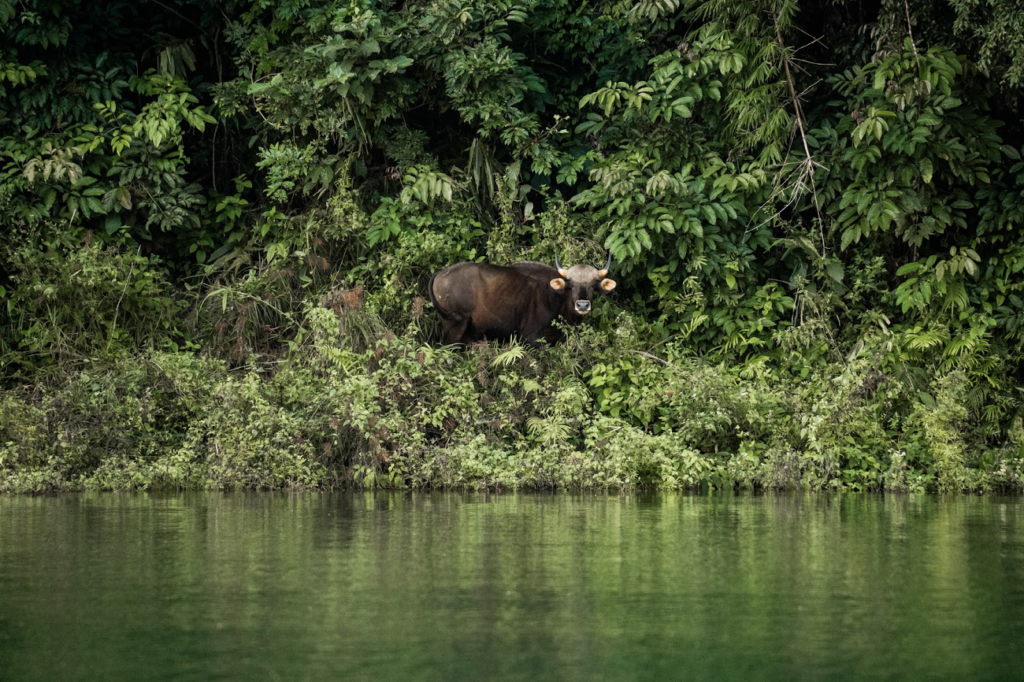
The dense forest and an animal sighting in the national park. Photo Credit: Adam Moore
When I think back to when I was seven years old in the forest, I remember being surrounded by trees, mountains, rivers, and a green, happy life. I want to go back to that. That’s what makes everyone feel good and connected to nature. Connected with their soul. Today, we are working on numerous projects to adapt to the changes we’re facing. Our community-based tourism is all about getting back to our roots. People are realizing that life is more important than making money and are trying to help each other more. We’re connecting more with one another, trying to help each other.
We’re focusing on staying healthy in any way we can, growing our food in the community as if we were back in the forest, selling to our community, and using tourism so that the benefits circulate entirely within our community. We are getting better at supporting each other than we were years ago.
CHUEN’S HOPE FOR THE FUTURE
I want to see more development in my community, where people share together, take care of each other and especially help our younger generation. I hope for a future where they have a safe and protected village to call home, a place that is green and filled with educated, respected people. I wish for a slight return to the way things used to be, even though I know we cannot go back into the forest. Today, I still want to keep finding ways to enjoy our natural world together.
We need to share our problems and work through them collectively, whether we are experiencing pain or happiness. I believe that the community work we are doing can help us achieve this. But it means that we need more people coming to see us, asking us questions, being interested in our village and culture, and wanting to see what we call home.
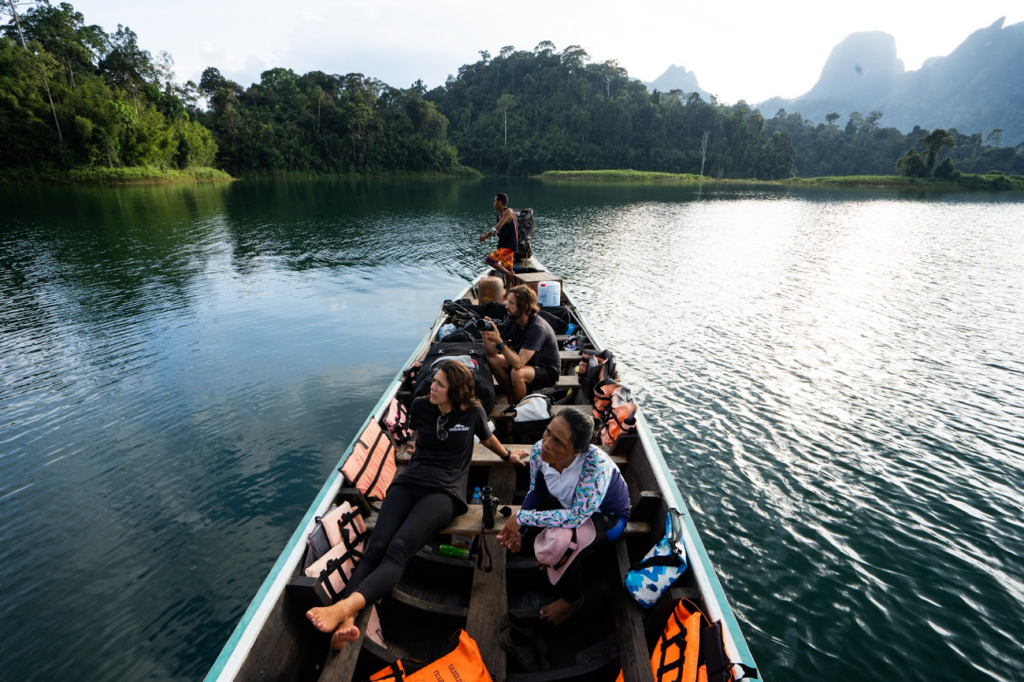
Chuen shares her home with the Edges of Earth team. Photo Credit: Marla Tomorug
For those who come to visit us, I want to emphasize the importance of gratitude. Be happy with what you have. When you come here, don’t expect too much, but be happy with what you see. Understand that happiness, for us, is found in the mangroves, wetlands, forest, streams, rivers and the ocean. It’s found in traditions and spirits. It’s found among family and community bonds that are unbreakable here. If you can appreciate the life you have and learn to cherish the simple things, you will be as happy as we once were in the forest.
As told to Andi Cross in June 2024.
ABOUT THE OCEAN BREAKTHROUGHS
Resulting from the joint efforts of the Ocean & Coastal Zones community under the Marrakech Partnership for Global Climate Action, and building on the Ocean for Climate Declaration, the Ocean Breakthroughs have identified five turning points to reach by 2030 in order to achieve a healthy and productive ocean in 2050. They are articulated around the most crucial ocean sectors: marine conservation, ocean renewable energy, shipping, aquatic food, and coastal tourism. Accelerated action and investments in each will help unlock the potential of the ocean as a source of solutions to the pressing challenges posed by climate change and biodiversity loss.
Coastal and marine tourism is the largest economic sector for most small island developing states. In a business-as-usual scenario, coastal tourism would likely become the largest ocean economy sector by 2030 globally. While the development of tourism remains highly positive for global economies, mass tourism on the coasts and at sea implies serious environmental impacts. For instance, tourism is a highly emission-producing industry with a major part concentrated in coastal areas.
At the same time, coastal tourism is particularly exposed to the impacts of climate change and biodiversity loss. Infrastructures are increasingly threatened by extreme weather and slow on-set events such as sea level rise. In addition, the industry is highly dependent on healthy coastal and marine ecosystems to offer leisure activities and attract visitors. The future of coastal tourism and its sub-sectors is therefore deeply reliant on its capacity to change and develop sustainably.
The scientific evidence is clear: as a major climate regulator and the largest living space on Earth, the ocean is integral to deliver on the goals of the Paris Agreement and the Global Biodiversity Framework. The Ocean Breakthroughs are science-based targets designed to boost mitigation and adaptation efforts, for the benefit of People and Nature. They will contribute to delivering on the global campaigns led by the UN Climate Change High-Level Champions, namely the Race to Resilience and Race to Zero, and their respective action agendas: the Sharm-El-Sheikh Adaptation Agenda and the 2030 Breakthroughs.
ABOUT THE HLC X EDGES OF EARTH EXPEDITION
The women-led global expedition, Edges of Earth, has partnered with the UN Climate Change High-Level Champions (HLC) to bring to life the Ocean Breakthroughs initiative by sharing personal accounts and climate action stories from remote coastal communities. This media partnership will feature interview-style stories that highlight the experiences and efforts of locals, Indigenous communities, nonprofits, and ocean scientists in addressing climate change. Celebrating its one-year anniversary, Edges of Earth has traveled to 25 countries (with nearly 30+ more to go throughout 2025) working closely with diverse groups to understand and amplify their climate resilience strategies. Through this collaboration, Edges of Earth will spotlight the five Ocean Breakthroughs—marine conservation, ocean renewable energy, shipping, aquatic food, and coastal tourism—by showcasing diverse voices and solutions to accelerate global climate action.

